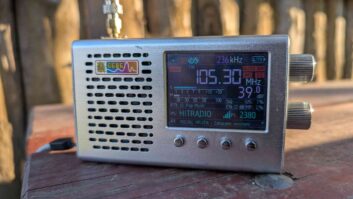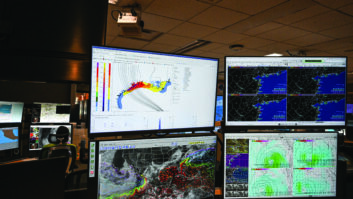“Milestones” is a series of occasional articles about important or memorable technologies and products that influenced today’s radio broadcast industry.
My first job out of the army in May 1970 was as chief engineer of a small 1,000 watt full-timer in Hilo, Hawaii.
I was living the fantasy depicted by WKRP: an involved audience, limited competition, AM radio dominance, great new music coming down the pipeline from landmark artists, talented people on a tiny staff. On air, who could ask for anything more?
The “summer of love” might have passed elsewhere, but here life meant surf, sun, skin … a paradise found. F. Scott Fitzgerald could have written a novel about us and our hedonistic lifestyle.
On the tech side, only the arrogance and intoxication of youth could make one decide that the entire station needed to be rebuilt.
The sagacity of age allows one to realize that you don’t touch what’s right but focus primarily on what’s wrong.
Muscle
I’ve always loved RF and so the transmitter site was my priority.
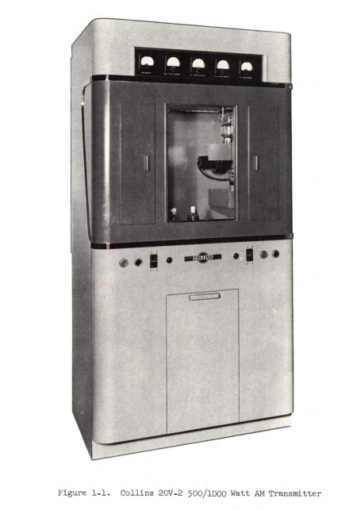
My enthusiasm for “improvement” must have found resonance with ownership, as they approved the acquisition of a used twin to match the existing Collins 20V-2 main transmitter.
After an endless number of overnights, we had a matched pair of alternate main 20Vs ready for service.
KHLO was on 850 kHz and it was the only station I’ve encountered that had two antenna exceptions. The first was for a drastically reduced radiator of about 170 feet on 850, the other was a reduced ground screen made up of a limited number of short radials.
The self-supporting tower originally had been taller and located on a rock island in the bay adjacent to the hotel district near the beautiful Queen Liliuokalani Gardens.
When the city wanted to spruce up the area, it ordered the tower to move. A helicopter transported the sections to its new home a few miles down the coast, the tidal area of a tropical fish farm (ground conductivity about 5,000 siemens!) on the ocean.
Things went well until the heavy bottom section, too challenging for the helicopter, got to swinging and the pilot dropped it in the bay.
Voilà! KHLO had an instantly shorter tower.
(Incidentally, the tower was iron, not galvanized steel. Eventually, the moisture and the salt got it. Rusted away, the stick collapsed — probably more accurately, it crumbled — in high winds in the 90s. At present, KHLO and two other AMs triplex a tower on the other side of Hilo.)
The emergence of the radials in tidal salt gave the station an extraordinary, intense signal along the coastal sections of the Big Island and over water towards the other islands and the mainland. QSLs from the West Coast were constant.
The FCC accepted the new truncated tower and only 30 or so short radials.
The Big Island is the biggest mountain in the world, thanks to its roots five miles down at the bottom of the Pacific plus the equatorial bulge, which adds to its height from the center of the earth.
Mauna Kea, top of the island, is also the biggest rock in the world with almost negative ground conductivity. OK, that’s hyperbole, but inland, inverse to our coastal coverage, our signal was challenged.
Our Collin 20Vs were the muscle that made our signal dominate.
West Point gray
Three versions of the 20V were manufactured.
According to the Collins instruction books, the 20V-1 (properly called the 20V) and the 20V-2 had the old “West Point gray color with General Grant styling” of pre-1961 or so. The 20V-3 was in the newer style, in a sort of beige.
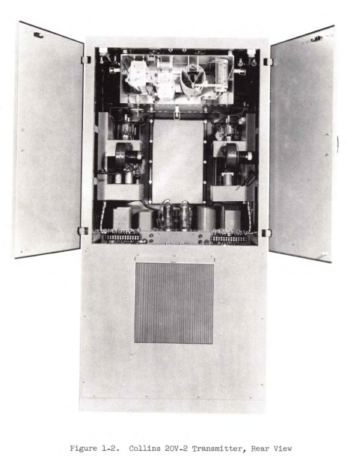
Of the 1 kW transmitters we’ve been discussing in these Milestone columns, the Collins probably was the most physically overbuilt, deluxe of them all.
The styling grew out of the previous model 550A-1 and was a subdued Art Deco, with two small door panels to give access to controls and slender recessed lamps to illuminate the meter bridge.
To be competitive, the design engineers had to meet a price and then allot their budget to the areas they deemed most important. My judgment is that the Collins staff directed the money to RF and support circuitry.
The entire transmitter has an elegant simplicity to it.
On the RF side in models 1 and 2, a 6AU6 oscillator buffered by a 6SJ7 couples to an 807 driver exciting parallel 4-400 final output tubes similar to the Bauer 707 less the RF drive sense relay.
The output tuning was a “pi” network followed by an “L” section without a second harmonic trap. Capacitors tuned the network.
One unique feature was the arc suppressor circuit. The design concept was to avoid transmitter damage if RF arcing or lightning induction current was present in the output or the antenna. When any exceptional sort of current was detected flowing at the transmitter output, the arc suppression relay would activate and shut off high voltage.
This circuit worked; I’ve seen it go through its paces in several lightning storms. But it required that only RF be present on the output in normal operation. Even a tiny bit of leakage to/from the AC of tower lighting could hold the relay open.
On the audio/modulator side, the 20V-2 had only two gain stages.
A push-pull pair of 6SJ7s were directly coupled into a push-pull pair of 4-400s. Push-pull circuits intrinsically cancel second (or even) harmonics and even lower distortion was accomplished by liberal audio feedback from samples derived from the plates of the 4-400s fed back to the grids of the 6SJ7s.
The Bauer 707 transmitter with a similar circuit used 8 dB of feedback. The 20V probably had closer to 12 dB.
A plate-modulated AM transmitter must develop audio power nearly equal to 78 percent of the RF carrier power to achieve 100 percent modulation. A gain in level between +10 dBm input into 600 ohms (0.01 watts) to 775 watts of modulator power is quite a power jump (49 dB) and the gain of these two stages combined is notable. Feedback was needed not only for fidelity but also for stability.
Another deluxe feature: The 20V had circuit breakers as opposed to fuses for both the filament and plate branches of the input power.
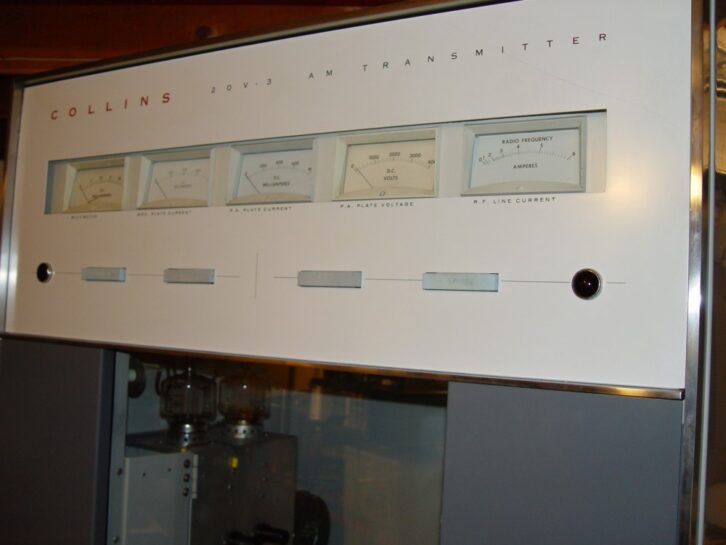
Radio surfing
The transmitter had a cabinet fan plus a separate squirrel cage blower on the RF and audio main chassis with their 4-400s. These three blowers made this rig sound powerful even when it was just cooling down.
The 20V-1 was local control only; most subsequent 20V-2 and -3 units had provision for remote control, though documentation was sketchy. I had fully modified mine for remote control. Another difference: the 20V-3 had solid-state rectifiers throughout.
My 20Vs had a circuit feature not seen in other rigs of this vintage, an audio tap. Down in the current return path of the RF finals a resistor was installed at the ground connection point creating a small voltage drop that was just perfect to drive an amp with a sample of the modulation envelope. (See schematic in online version of this Milestones article at radioworld.com.)
The sound of that speaker was comforting as you entered or exited the transmitter building. You knew all was well.
An overnight maintenance chore unique to my ocean site was polishing the transmitter. Caustic salt air could cause deterioration, so these were the only transmitters where I had to “Simonize” the exposed metal surfaces with automobile wax.
After such an overnight (and especially if I intended to stay up all day — ah, the stamina of youth), I would walk across the street to the beach park, strip and swim in the surf as the sun came up.
I may have been reckless, freestyling in the riptide alone, but I certainly was awake when I finished — though I had to be careful not to let the incoming tide carry away my clothes.
The Collins 20Vs were overbuilt, generally, but quality throughout and a joy to operate and maintain.





